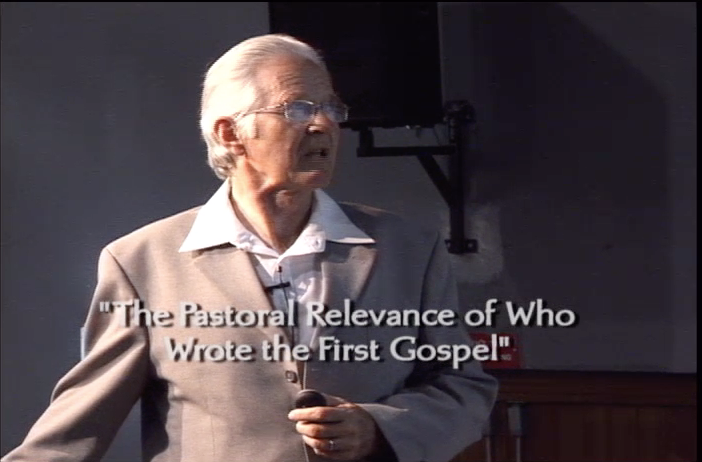Watch this two-part video lecture here.
The Importance of Bible Geography for Understanding Jesus

The complete 2006 lecture is now accessible to JP users. View now!
The Pastoral Relevance of Who Wrote the First Gospel

The complete 2006 lecture is now accessible to JP users. View now!
A Statistical Approach to the Synoptic Problem: Part 4—Non-Linear Hypotheses

In Part Four of his series, “A Statistical Approach to the Synoptic Problem,” Halvor Ronning compares Lindsey’s theory of Lukan Priority to alternative solutions to the Synoptic Problem.
A Statistical Approach to the Synoptic Problem: Part 3—Single Tradition

In Part Three of his series, “A Statistical Approach to the Synoptic Problem,” Halvor Ronning examines the data concerning the degree to which each of the Synoptic Gospels was influenced by a Semitic language (Hebrew or Aramaic). Ronning analyzes this data to see whether it can help us unravel the vexed question: “Who wrote first? Matthew, Mark, or Luke?”
A Statistical Approach to the Synoptic Problem: Part 2—Double Tradition

In the previous article of this series Halvor Ronning examined the statistics of verbal identities involved in comparisons between materials shared by all three Synoptic Gospels (Triple Tradition). Now in Part Two Ronning will bring into consideration the statistics pertaining to materials shared in only two Synoptic Gospels (Double Tradition). Ronning wiargues that the consistency with which an author treats his sources is a major clue for determining the order of Synoptic dependence.
A Statistical Approach to the Synoptic Problem: Part 1—Triple Tradition

“A Statistical Approach to the Synoptic Problem,” a new series on Jerusalem Perspective by Jerusalem School of Synoptic Research member Halvor Ronning, aims to contribute to the body of empirical data that must be accounted for by any viable theory that attempts to describe the interrelationships between the Synoptic Gospels. To that end, Halvor Ronning has developed and adapted several new methods of quantifying and testing synoptic hypotheses which will be described and applied in “A Statistical Approach to to the Synoptic Problem.”
Windows on Jesus: Lesson 1: Introduction, Definitions, Premises

Begin learning about the academic study of Jesus’ life and teachings (or enjoy a refresher course) by “sitting in” on “Windows on Jesus,” Halvor Ronning’s fifteen-part lecture series on the Synoptic Gospels and the Synoptic Problem.
Windows on Jesus: Lesson 2: Synoptic Problem – Differences of Wording and Story Order

Lesson Two of “Windows on Jesus,” a fifteen-part course on the Synoptic Gospels with Halvor Ronning of the Jerusalem School of Synoptic Research.
Windows on Jesus: Lesson 3: The Facts – Charts for Each Gospel

Lesson Three of “Windows on Jesus,” a fifteen-part course on the Synoptic Gospels with Halvor Ronning of the Jerusalem School of Synoptic Research.
Windows on Jesus: Lesson 4: Origins of the Jerusalem School of Synoptic Research

Lesson Four of “Windows on Jesus,” a fifteen-part course on the Synoptic Gospels with Halvor Ronning of the Jerusalem School of Synoptic Research.
Windows on Jesus: Lesson 5: Cooperation of Christians and Jews

Lesson Five of “Windows on Jesus,” a fifteen-part course on the Synoptic Gospels with Halvor Ronning of the Jerusalem School of Synoptic Research.
Windows on Jesus: Lesson 6: The Jerusalem Theory of Gospel Relationships

Lesson Six of “Windows on Jesus,” a fifteen-part course on the Synoptic Gospels with Halvor Ronning of the Jerusalem School of Synoptic Research.
Windows on Jesus: Lesson 7: Texts That Illustrate the Theory

Lesson Seven of “Windows on Jesus,” a fifteen-part course on the Synoptic Gospels with Halvor Ronning of the Jerusalem School of Synoptic Research.
Windows on Jesus: Lesson 8: Other Theories and Their Consequences

Lesson Eight of “Windows on Jesus,” a fifteen-part course on the Synoptic Gospels with Halvor Ronning of the Jerusalem School of Synoptic Research.
Windows on Jesus: Lesson 9: Benefits of the Jerusalem Theory of Synoptic Relationships

Lesson Nine of “Windows on Jesus,” a fifteen-part course on the Synoptic Gospels with Halvor Ronning of the Jerusalem School of Synoptic Research.
Windows on Jesus: Lesson 10: Importance of Hebrew

Lesson Ten of “Windows on Jesus,” a fifteen-part course on the Synoptic Gospels with Halvor Ronning of the Jerusalem School of Synoptic Research.
Windows on Jesus: Lesson 11: Jewish Backgrounds

Lesson Eleven of “Windows on Jesus,” a fifteen-part course on the Synoptic Gospels with Halvor Ronning of the Jerusalem School of Synoptic Research.

